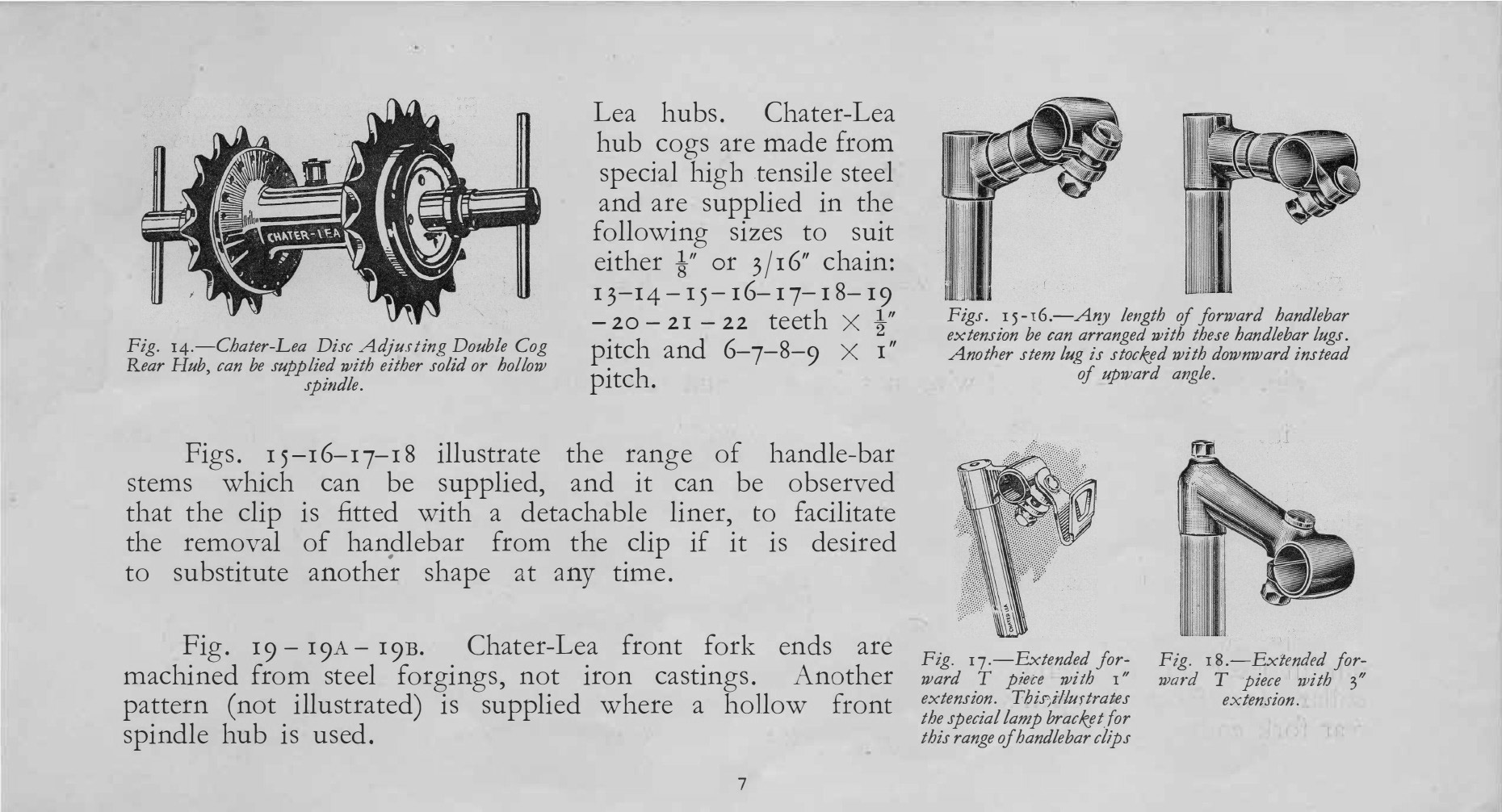The demise of British component manufacturers?
Posted: Tuesday 16th June 2020
The response of the British cycle components industry to the increasing preference for continental products starting at the end of the 1940’s
INTRODUCTION
The scope of this article is to look at the response of the British components industry to the increasing popularity of continental lightweight parts. Towards the end of the 1940’s/ early 50’s the British components industry began to lose its dominant position as club cyclists began to prefer European equipment. In an attempt to counter this some companies copied continental designs or used the magic word continental in their marketing.
BACKGROUND
Prior to WW2 imported equipment was a rarity. Import tax was high, making prices much higher and the volumes were small. It was extremely unusual for cycles to be equipped with non-British parts. It was only the smaller more innovative companies who offered continental equipment as an option, examples being Rensch, Hobbs, Claud Butler and Hetchins. In 1935 BSA considered offering a model with the Italian Vittoria Margherita gear but this was never marketed.
There was prevailing view that British was best. This was particularly true with respect to gearing; the British cyclist had no need of the crude chain shifting devises of the French. Cliff Pratt, later the founder of the CTC York Rally and Hull cycle dealer, describes how in November 1929 he was one of the very first British cyclists to fit a variable gear (a French Standard Cyclo) and just how unusual this was with most club riders on fixed. The contrasting national attitudes to gears are extremely well documented in Frank Berto’s ‘The Dancing Chain’.
The major change in post war attitudes began during WW2 and reflected the great level of social change leading to the landslide Labour victory in 1945. Soldiers returning from the war dissatisfied with the old order and ways and keen for change.
The image of cycling was important too in determining attitudes. In Britain it was seen as utilitarian but in Europe as attractive mainly due to the road-racing scene. Post war import restrictions merely made continental equipment more desirable – “you want what you can’t have”. Ron Kitching autobiography ‘A Wheel in Two Worlds’ has some now almost hard to believe examples about the draconian customs rules. In the early post war period he pretty much had to smuggle equipment in. There was probably also an element of the grass is always greener on the other side.
Throughout the 1950’s the cycling establishment still clung to the view that British were best. A good example can be found in the review of the 1955 Paris Show in the CTC Gazette by the then secretary Reg Shaw. The article was subtitled ; “”on the whole we do things rather better over here”. Whilst admitting that specialist builders like Rene Herse and Alec Singer produced an excellent product, the reader was left in no doubt that French products were inferior. Even where it was admitted we had copied the British version was superior. Re-reading these articles it seems very strange that a review of the Paris show would concentrate on British products e.g. Brookes and Raleigh. However, at the time it was seen as the Press’s job to encourage people to buy British.
Many British companies were slow to innovate, for example:
1. With the resumption in production after the war many companies merely offered their pre-war range, a prime example being Chater-Lea.
2. Before 1955 British Cyclo mainly made gears for 1/8″ chain/cogs although riders wanted 3/32. The Standard Cyclo was never made in Britain in 3/32
3. Prior to 1954 no Raleigh bike was supplied fitted with a derailleur
There was some innovation, mainly amongst the smaller companies e.g. Harden (hubs and bottom brackets), Strata (brakes, handlebars toeclips) and GB (brakes and handlebars). However, many of the newer companies did not last long in the cycle trade e.g. Shellwin only made their innovative hubs with the angled flanges in 1948/9 (below).
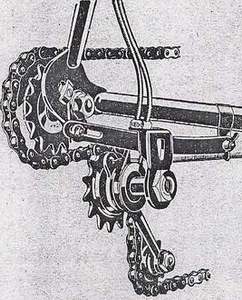
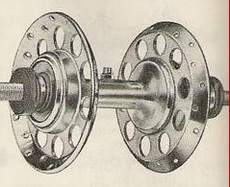
THE BRITISH RESPONSE: PRODUCTS
During the late 1940’s most component companies were required to concentrate on exports, which starved the home market. Supply only really caught up with demand in 1950. Many adverts of the period stress that export has priority and goods may not be in stock. Sturmey Archer ran an advert until 1949 which consisted of a dialogue between a cyclist and a “stocks are difficult to obtain at the moment but I’ll put your name on a waiting list”.
Lucas ran an advert featuring a picture of some beef steaks explaining that the priority being given to export was enabling the British population to put meat on the table.
With the increasing economic prosperity import restrictions were eased, with the result that for the first time continental products became widely available. Gnutti hubs and chainsets were amongst the first products to be both available and affordable. It was not until a couple of years later that British companies began to offer continental styled products. The remainder of this article discusses some examples:
Bottom Brackets: Bayliss Wiley (BW) Featherweight bottom bracket set. Described as new in 1953. A weight saving of 50g mainly achieved by hollowing out the axle. This was a copy of Stronglight with the fixed cup being octagonal and the adjusting cup hexagonal. Brampton produced a similar item a year later. Both were very high quality items comparable to anything else on the market
BW no’s 14 and 23 cottered bottom bracket axles. With the increasing popularity of derailleur there was a demand for longer bottom bracket axles. The no. 23 were for a 5-speed and the no. 14 for a double chainwheel. Until 1953 they had only offered for lightweights the no. 15 with ngcc (none gear-case clearance). BW also produced a cottered axle, no. 8 for the slightly wider Continental bottom brackets shells (70mm as opposed to 68mm) and wider on the gear side. This was for the 5-pins Stronglight design used by Gnutti, Duprat, and Durax etc and later by Milremo and TA.
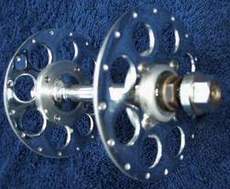
Large Flange Hubs: since the 1930’s large flange hub were known in Britain as the continental. It is not entirely clear which continental hub this was derived from. It may have been Prior (French) who in the 30’s marketed very large riveted flanged hubs to meet the demands of fashion in the late 30’s the British Hub Company (BHC) riveted flanges to the Airlite to create the first version of the Airlite Continental. These are now very sought after by collectors but have a major flaw in that after prolonged use the rivets work loose.
Post-war the Airlite Continental was a three-piece steel barrel on alloy flanges. In the mid 50’s BHC introduced the Racelite a copy of large flange Normandy and other similar French hubs. BHC marketed the Racelite as the first single piece British alloy hub. Other companies like Resilion, Powell, Coventry Ultralite and BW offered large flange hubs marketed as Continental (fig 4).
Headsets: Brampton Alatet set; with its knurled screwed race and toothed lockring washer it was a direct of copy of the Stronglight. According to the review of the London show in the CTC Gazette in Dec 1952 it was a superior version. However, most riders viewed it as an inferior product due to the teeth wearing allowing the screwed race to come loose. TDC who took over from both Brampton and BW in early 60’s marketed their more expensive headsets with Italian sounding names eg Prima and Italia.
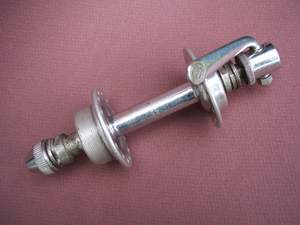
Quick Release hubs ; BHC offered a q/r using the Airlite design. These are easily identifiable having BHC on the skewer tip. They used a British thread so the locknut end is not interchangeable with any other make, all of which were continental. According to the 1962 Holdsworthy Aids at 80/-, these were 8/- more expensive than the Campagnolo Grand Sport. Both hubs were three pieces with steel barrels so I suspect by this time most cyclists would have opted for the cheaper Italian product. As a consequence of their rarity they had become sought after by some of the ‘gen’ lightweight collectors. However, in one aspect the British product was superior, the quality of the chroming.
I have seen Harden hubs with quick release axles and BHC skewers, however these were home modifications.
BSA and Constrictor quick release hubs. In 1953 BSA marketed a front hub which could be removed leaving the track nuts attached to the forks. As a spanner was still needed for wheel removal it was hardly quick!
Constrictor never made a quick release hub, rather they offered a conversion for the rear hub. This was very similar to a pre-war conversion offered by Chater Lea. Described as new in their 1955/6 catalogue (fig 9). According to the 1962 Holdsworthy Bike Riders Aids: “the Q/R skewer is wound out of the hub by means of a short leaver and withdrawn. This allows the wheel to drop out, but leaves the fixing nuts in position so the wheel is automatically returned to the same position”.
Gears; with the advent of the Campagnolo Gran Sport parallelogram rear mech, plunger type gears became obsolete. Their response was in 1960 to offer the Super 60 and P2 (the economy version). These were essentially copies of the Gran Sport but the Super 60 has some additional features, notably an angle arm adjustment. These were the last British-made gears and after this Cyclo concentrated on spares and tools.
CONCLUSION
Looking back, the decline in the British cycle components industry started in the mid 50’s and continued at an increasing pace. Partly it could be blamed in the rise of the motor car. Ron Kitching blames the decline on the monopoly position of Raleigh by the late 1950’s, which enable them to force down supplier prices to such a point they could not remain in business. He illustrates the decline with reference to his Everything Cycling catalogues: in 1948 this featured 120 British companies, in 1988 only 13. Ron denies his pioneering importing of continental equipment had anything to do with this!
Bayliss Wiley ceased to make cycle parts around 1960; BHC and Constrictor both ceased at the end do the 60’s. Even adding the magic word continental to products was not enough to save them …
REFERENCES
Ron Kitching: A Wheel in Two Worlds, 1993 (the two worlds being cycle racing and cycle trading. One of the very few books written without any thought of being sued).
Frank Berto: The Dancing Chain, 2005
Cliff Pratt : Sixty Six years as a Cycle Tourist, 1994 Pentland Press
Holdsworthy Bike Riders Aids: 1949 to 1976 (a cursory glance reveals a steady decline in British products, both in volume and prominence)
1956 Stronglight Catalogue
1955/6 Constrictor catalogue
CTC Gazettes 1940 to late 50’s. Useful for the adverts and the show reviews and correspondence illustrating attitudes to continental equipment (e.g. a somewhat patronising attitude to the annual Paris show contrasting with an uncritical one to the London show).
Posted: Tuesday 16th June 2020
This article appears in the following categories.
Upcoming Events
Whether you are looking for a gentle social meet up, or a 100-mile ride browse the community’s upcoming events and plan your next weekend outing.
